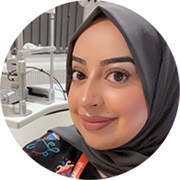- OT
- Life in practice
- Practitioner stories
- “We see patient satisfaction every day”
You had me at hospital
“We see patient satisfaction every day”
Every edition, OT poses a series of questions to a hospital optometrist. This time: SpaMedica’s regional optometrist lead for South and West Yorkshire, Sadiya Mulla
4 min read

02 November 2023

Sadiya Mulla
Occupation:Regional optometrist lead
Location :SpaMedica Wakefield
Hospital optometrist since:2019.
Could you describe working as a hospital optometrist in one sentence?
Rewarding, challenging, interesting and amazing – often all at the same time.How long have you worked as a hospital optometrist?
I’ve worked as a hospital optometrist for four years now. Sometimes it feels longer than that, because of the opportunities and depth of experience I’ve had in a short space of time.When and why did you decide to become a hospital optometrist?
I’d considered being a hospital optometrist while I was studying optometry at the University of Bradford, and I thought about it more after I qualified.Then, whilst working as a resident optometrist in a community practice, I dealt with a patient who had a significant abnormality pressing on her spine, which affected the signalling of the optic nerve. I saw just how important the role of optometrist was in triaging our clinical findings. This life-saving situation was the point where I knew I wanted to become a hospital optometrist.
Do you do any other work or volunteering alongside hospital optometry?
Currently I work full time at the hospital, although I worked in a High Street practice for two years prior to joining SpaMedica.I’ve found that knowledge on spectacle prescriptions, prisms, multifocal contact lenses and varifocals helps with correction recommendations after cataract surgery. As a hospital optometrist your knowledge on pathology deepens, which allows you to triage effectively in the community setting.
As a hospital optometrist your knowledge on pathology deepens, which allows you to triage effectively in the community setting
Can you name one moment that has made your job feel valuable?
Certainly during the COVID-19 pandemic. As restrictions started to ease, it felt like we were making a very big difference, helping patients access the care they needed and working to reduce waiting times. We only closed our eye hospitals for a short time at the start of the pandemic, and then our teams worked tirelessly when returning to make sure patients continued to get the care they needed.We see patient satisfaction every day, and always receive lots of positive feedback, which is a great part of this job – but that particular period sticks out for me, as it does for many. We were working exceptionally hard for our patients, when they were facing such stress and uncertainty.
What is the biggest challenge facing hospital optometry currently? How can this be resolved?
In an ageing population, we’re seeing increasing numbers of patients with conditions such as glaucoma and acute macular degeneration (AMD), who need ongoing monitoring and treatment. We need to continue upskilling, ensuring that greater numbers of hospital and community optometrists can provide care in these areas – giving patients the right care at the right time.I received intensive training when I joined SpaMedica, and continuing professional development events are held every month for all company optometrists. SpaMedica hosts regular accreditation events and open evenings for community optometrists too.
We need to continue upskilling, ensuring that greater numbers of hospital and community optometrists can provide care
What is hospital optometry’s biggest success in the past three years?
I’d say it has been the diversifying of our role. The pandemic created a shift in optometrists increasing their skills, allowing workloads to be shared between us and consultants.When I left university, hospital optometrists would generally only see patients for pre-op and follow-up appointments. I don’t think we thought that hospital optometrists would be facilitating YAG capsulotomies and AMD IV injecting, and yet here we are. I’ve welcomed the opportunities to expand my skillset and love the variation in the role.
What is your biggest success in the past three years and why?
Being promoted from hospital optometrist to regional optometrist lead. Not only am I looking after a fabulous team, but I’m also involved with some really interesting projects, such as our first glaucoma monitoring service at SpaMedica, which recently launched in Yorkshire.What is the most surprising case you’ve seen in the hospital setting?
I had a patient with a very limited fundal view, due to an immensely dense cataract. He came back for a follow up appointment with limited vision post-surgery. This was because he had a choroidal melanoma filling his macula region. Luckily, the patient’s eye was saved from enucleation.What would you say to optometrists working on the High Street about working in a hospital environment?
It is the most rewarding job. Regularly seeing the reaction of patients, when you have changed their eyesight for the better and given them their independence back, makes coming to work so much more worthwhile.


Comments (0)
You must be logged in to join the discussion. Log in